Rogues are the assassins of the Warcraft world. Their fighting style centers around dealing quick blows with dual-wielded daggers (or other one-handed weapons) while constantly going in and out of combat. Rogues can conceal their presence with their stealth abilities in order to circle around their foes, waiting for the best opportunity to strike from behind.
Rogues don’t play fair. They do everything in order to win, so cheap shots and throwing sand is not out of question. Even if they don’t kill their opponent right away, they often leave a deep, bleeding wound that will eventually finish the job.
Besides combat skills, Rogues are also masters of poisons. They prepare deadly mixtures, which they coat their weapons with. Poisons generally wound the target, but can also cripple them or hinder spellcasting.
In Hearthstone, the Rogue class is represented by the Valeera Sanguinar. Players can also unlock an alternative, cosmetic Rogue Hero – Maiev Shadowsong.
Themes and Mechanics
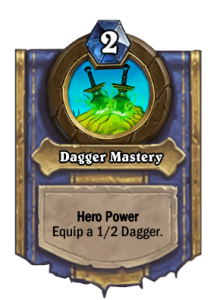
Rogue’s Hero Power is Dagger Mastery. After using it, Rogue creates and equips a weapon – a 1/2 Wicked Knife. While comparable to some other Hero Powers that can “ping” (deal 1 damage), like Mage’s or Druid’s, Rogue’s Hero Power is unique in a way that it’s not instant and has two charges. This means that Rogue can set up the Hero Power on a turn with spare mana and will still have two full charges to work with later in the game. This makes Dagger Mastery the highest tempo among all of the Hero Powers. However, since attacking minions damages your Hero and the Hero Power doesn’t give any extra Armor or Health, it’s also one of the riskiest ones and using it correctly is one of the requirements of mastering the class.
Combo is the Rogue’s unique mechanic. It’s a bonus ability of a card that activates only if another card was played before it on the same turn. It will be easiest to explain with an example. Eviscerate deals 2 damage for 2 mana, which is really low. But if you’ve already played any other card this turn (including Coin), the combo part activates and the card 4 damage instead, which is very powerful for a 2 mana card.
Combo cards are generally very weak if you don’t activate the Combo and very powerful if you do. They’re balanced by the fact that they often can’t be played on curve with their Combo effect active (unless one of the 0 mana cards was played first). Similarly, combo effects can’t be activated when it’s the only card you can play on a given turn (e.g. the rest of your cards are too expensive to play or have no target).
Some of the Combo cards get a bonus effect each time you play a card, not only for the first card you’ve played. There are two cards like that right now – Edwin VanCleef and Biteweed, which gain extra stats for every card played before them (on top of the base stats). So, for example, Edwin VanCleef will be an 8/8 minion if you’ve played 3 cards before him.
Learn more about Rogue in World of Warcraft via Wowhead’s class guides: Assassination Rogue Guide, Outlaw Rogue Guide, or the Subtlety Rogue Guide!
Recently, Rogue has also became the fourth class with Secrets available. However, Secrets won’t likely be a permanent theme of Rogue – devs have implied that it’s mostly an one-time thing from Kobolds & Catacombs expansion, and while they might come back in the future, they won’t turn Rogue into another Secret class.
There are also some ongoing themes when it comes to the Rogue cards. When new cards are released, there is a significant chance that some of them will fall into one of those categories:
- Pirate – Pirates are the Rogue’s main tribe. Rogue is the class with most Pirate minions (e.g. Luckydo Buccaneer, Swashburglar, Southsea Squidface) and Pirate synergies (e.g. One-eyed Cheat, Shady Dealer). That said, most of the Pirate Rogue decks created so far haven’t been very successful.
- Stealth – One of the ongoing themes in Rogue are the Stealth cards and synergies. While it seems that Blizzard is trying to back down with the number of Stealth cards in the Standard (because they’re, by nature, very noninteractive), it’s widely available in Wild. Rogue has cards with Stealth (e.g. Shadow Rager, Lotus Assassin), as well as the cards that give Stealth (Conceal, Master of Disguise) and a card that synergizes with Stealth (Shadow Sensei). Whether Blizzard will continue to develop this theme more is unknown.
- “Burgle” Effects – There is no official name for this kind of effects, but they are usually called this, out of reference to the first card created with that effect – Burgle. Unlike other classes, Rogue “card draw” usually draws/discovers cards from the opponent’s class. And unlike the Priest “copy” effects, the cards aren’t from the opponent’s deck – they’re random cards from the class, which makes the range of outcomes even higher. The most common examples of such cards are Hallucination, Swashburglar and Undercity Huckster. There are also cards that synergy with stolen cards – Ethereal Peddler and Obsidian Shard.
- Deathrattle – Along with Hunter, Rogue is the class with most Deathrattle cards. The class has multiple Deathrattle minions like Deadly Fork, Southsea Squidface, Xaril, Poisoned Mind or Tomb Pillager. Rogue can also Discover a Deathrattle card with Journey Below and copy a friendly Deathrattle effect with Unearthed Raptor (Wild-only).
- Weapons & Weapon Buffs – Rogue is obviously one of the weapon classes, but it’s much more focused on the weapon buffs than the others. Most of the Rogue weapon buffs give extra points of attack – Deadly Poison, Southsea Squidface, Goblin Auto-Barber, Tinker's Sharpsword Oil etc. However, Rogue can also give the equipped weapon a Poisonous tag with Envenom Weapon and Lifesteal with Leeching Poison.
- “Bounce” Mechanics – Rogue has multiple cards that can bounce minions back to their owner’s hand. Some affect enemy minions only, some just friendly minions, and others are mirrored to affect the whole board. Some examples of the bounce cards are: Sap, Shadowstep, Gadgetzan Ferryman, Kidnapper and Vanish.
Strengths and Weaknesses
Strengths:
![]()
- Tempo – Rogue is the ultimate tempo class. Most of its decks are built around tempo or tempo swings. While their early game is usually pretty slow (due to a low number of strong, cheap minions), in the mid game they can start swinging the game. Pretty much every Combo card is a high tempo card as long as the effect is active – e.g. Vilespine Slayer adds a 3/4 body to Assassinate and Edwin VanCleef is usually at least a 6/6 minion for 3 mana, which is really high tempo play. Many of the Rogue spells are naturally very high tempo cards – e.g. Backstab costs 0 mana, but it gives Rogue a board advantage. Another example is Sap – the card is often a pure tempo one, it gives no card advantage unless the minion was buffed. But probably the ultimate Rogue tempo card is Preparation – it gives up to 3 points of mana for free, trading card advantage for tempo.
- Cycling – Even though I’ll be talking about a Neutral card here, Gadgetzan Auctioneer has been a staple in Rogue decks for years now and Blizzard is supporting that tactic by releasing more cheap spells every expansion. Every slower Rogue deck, but mainly Miracle Rogue, has its late game based around Gadgetzan Auctioneer draw turns. It draws a card every time the player casts a spell. Given the amount of cheap spells Rogue has, including the ways to actually gain mana while still drawing (Preparation, Counterfeit Coin), one Auctioneer turn can often result in over 10 cards drawn. While it’s mostly cycling, some cards like Fan of Knives or Mimic Pod actually build card advantage. But the most important part is that all the cheap spells like Backstab, Sap or Eviscerate usually had at least some impact on the board, which means that in a single turn Rogue can play a 4/4 minion, draw multiple cards and clear the board.
- Burst Damage – Rogues are well-known for their burst finishers. Miracle Rogue often plays Leeroy Jenkins backed up by some damage cards like Cold Blood or Eviscerate. While nearly unplayable in Standard, another Rogue deck – Malygos Rogue – uses Malygos with a bunch of cheap/discounted spells (e.g. Sinister Strike) to deal over 20 damage in a single turn. Even the new addition to the class roster, Quest Rogue, is known for a high burst damage with the Charge minions bounced back multiple times.
Weaknesses:
- Weak Early Game – Rogue’s early game is generally very weak. Outside of some perfect hands, like playing a huge Edwin VanCleef, Rogues mostly play passively for the first few turns. Since their big tempo swings start in the mid game, they prefer to take the early turns slowly, prepare their Hero Power, draw some cards, and possibly clear some minions with their cheap spells. This makes Rogues very vulnerable to a very explosive starts from the opponent. Since they have no minions of their own to counter, if they don’t draw their early answers (mostly Backstab and Eviscerate), it’s very easy to rush them down.
- Lack of Survivability – Rogues in Hearthstone are essentially “glass cannons”. Even though they can deal a lot of damage and have some really powerful turns, their defense mechanisms are almost non-existent. Removals are their only way to counter Aggro decks and considering reactive nature of those, they are very weak against Charge minions, burn damage, and weapons. Rogue has no ways to heal and no class Taunts. They have to completely rely on the neutral options or, depending on the meta, just ignore the defense aspect and focus on what they’re better at – offense.
- Bad AoE – That wasn’t a big problem in the past, but after Blade Flurry got nerfed so much it became unplayable (it used to cost 2 mana and deal damage to both Hero and the minions), Rogue was left with no ways to counter board swarms. Right now the only way Rogue can deal AoE damage is Fan of Knives, but only one point of AoE damage is pretty weak unless combined with Spell Damage. To combat that weakness, Miracle Rogue focuses on the single target removal and tries to not let the opponent snowball, while Quest Rogue plays Vanish in order to reset the board.
Meta Decks and Strategies
Here are the Rogue decks you can use on the ladder in the current meta. While not every deck listed here is high tier, they all should be viable options, especially to climb through the lower ranks.
Tempo Rogue is an aggressive deck that strives to maintain a high level of tempo throughout the game. The deck typically runs little to no card draw and instead focuses on powerful plays and finishing the game before it runs out of resources.
Immediately following the balance patch, Prince Keleseth became the centerpiece of Tempo Rogue. In order to run the card and buff all minions in the deck by +1/+1 when it is played, the deck had to cut all two-drops, so no Eviscerate and no Golakka Crawler for that build. However, those sacrifices are well worth it, because getting Keleseth on Turn 2 (especially if you can follow it up with a Shadowstep and replay it) increases the deck’s power by a lot. Playing a buffed minion after buffed minion puts you ahead in the tempo war against similar decks, and puts a lot of pressure on the slower decks. It turns even the small minions into proper threats – for example SI:7 Agent being a 4/4 instead of a 3/3 is a huge difference, as it gets out of range of multiple removals, both single target and AoE. The buff also works very well with cards that summon multiple bodies, and most common builds do run a card like that – Saronite Chain Gang. Even after a single +1/+1, having a 2x 3/4 Taunt for 4 mana is very powerful in every matchup.
In addition to Prince Keleseth, it is Patches the Pirate that makes Tempo Rogue tick. Patches is the fastest way to benefit from the Keleseth buff, as it gets the buff while in the deck and can then be summoned on the board by playing another Pirate. Prince Keleseth followed by a Southsea Captain or a Southsea Deckhand and Hero Power are incredibly strong plays that generate a lot of tempo early in the game. If you have the Prince in hand, you generally do not want to play a Pirate before playing the Prince in order to buff Patches.
Miracle Rogue is one of the oldest archetypes in Hearthstone and it plays a very similar core cards and strategy ever since the game’s Beta. Miracle Rogue is pretty hard to classify, but I’d call it something between a Tempo and a Combo deck. In order to win the games, it focuses on the mid and late game tempo swing turns. Those turns usually put Rogue far ahead and forces the opponent to answer – e.g. Gadgetzan Auctioneer turns, big Edwin VanCleef, “clearing” minion with a Sap and then playing something yourself, summoning a bunch of 4/4’s in a single turn etc. The opponent has to answer each one of those tempo swing turns and will eventually run out of answers, which means that Rogue can freely play more minions and deal a lot of damage.
Gadgetzan Auctioneer is the most staple card of the Miracle Rogue decks. The deck runs two copies alongside multiple cheap spells – Preparation, Counterfeit Coin, Backstab, Sap, Eviscerate etc. While the spells themselves change depending on the expansion and the meta, the basic idea is the same. Rogue plays Auctioneer, plays multiple free/cheap spells to cycle through the deck, ideally gaining both card advantage and tempo. Not only does it put a target on the board that the opponent simply has to kill, but it lets Rogue draw all the threats needed in the given matchup.
The best tool the deck has got in the latest expansion is Fal'dorei Strider. It’s a 4 mana 4/4 that shuffles three more 4/4’s into your deck – so you invest only 4 mana to get four 4/4’s in total. However, first you need to draw them, so that’s where the heavy cycling becomes useful. Gadgetzan Auctioneer turn have never been so powerful
The two most common finishers are Leeroy Jenkins and Arcane Giants. The first one is a burst-based finisher, in the late game, with cards like Shadowstep, Cold Blood and Eviscerate, you can often deal 15+ damage from your hand, which is great in some matchups. On the other hand, Arcane Giants win condition is more board-based – dropping a 0 mana 8/8 in the late game, on top of doing something crazy like summoning a few 4/4’s and removing big minions can put the opponent in a very difficult, sometimes even unwinnable position.
However, the deck is not that great in the current meta. It’s mostly for the enthusiasts, players that love this kind of play style. It’s possible to get a good score with this deck, but you have to be really, really good at it.
Budget and Basic Decks
If you’re a new player without a big collection, you might be looking for a way to play Rogue without spending a lot of your Dust on the Legendaries.
A Basic deck is a deck with only the starter cards. Every player can make it after unlocking the class and leveling it up to 10 (which unlocks every Basic card). It’s a best solution if you have just started playing the game – you can test each class without investing into it.
A Budget deck is a cheap deck with no Epics, Legendaries or Adventure cards. Budget decks only run the basic cards + Commons and Rares, which makes them relatively cheap and accessible even for players who have recently started. Average budget deck will cost up to 2,000 Dust to craft, but the number goes down heavily when you own some of the cards already. Even with a relatively small collection, you should be able to build one with just a few hundreds of Dust.
Basic decks are mostly meant for the Casual mode and up to Rank 20 in Ranked. Budget decks can easily be played up to Rank 10 in Ranked, while some of the better ones can even get you up to Rank 5.
This deck is a Basic Tempo Rogue. To understand it correctly, first you need to know what the tempo is. To put it simply, tempo is a speed at which you play the game. It’s a high tempo play is generally a play that puts you ahead on the board relative to the mana cost, but usually at the cost of other resources like health or card advantage. For example, imagine that your opponent has played a Boulderfist Ogre and you answered it with a Sap. It’s a high tempo play, because you’ve dealt with a six mana card by using a two mana card. But at the same time, it costed you a card advantage – you’ve used one card, while your opponent still has a card in his hand, which he can play again. But now, instead of 6 mana, he had to spend 12 total mana to play his minion, which slowed him down significantly. A neutral tempo play is something like using Assassinate to deal with a Boulderfist Ogre. This play has average speed – it’s 1 for 1, you both spent about the same amount of mana and neither of you have gained any significant advantage. A negative tempo play is when your move is very slow, you spend a lot of mana and you don’t really do anything on the board. In case of this deck, Sprint is the best example. You spend 7 mana, so probably your whole turn (or nearly whole turn) while not doing anything that influences the board.
Rogue is a class that often relies on the tempo to do its plays, and while there aren’t as many tempo cards in the Basic set, you can get a general feeling of it with cards like Backstab or Sap, which are very high tempo. Playing Rogue also forces players to use the health wisely. Both the Hero Power and Assassin's Blade cost health when hitting minions. You want to use then to clear in order to get ahead, but you also have to control how much health can you lose without dying.
Basic Rogue is definitely not the strongest Basic deck, and it’s also one that new players might find complicated. But it might be a very fun and rewarding deck, plus it might teach new players about the basics of the tempo and using health as the resource.
- 0Backstab2

- 0Shadowstep2

- 1Cold Blood2

- 1Serrated Tooth2

- 2Bloodsail Howler2

- 2Eviscerate2

- 2Sap2

- 3SI:7 Agent2

- 4Elven Minstrel2

Tempo Rogue is a very old archetype, although the only time it was really popular (besides now) was the early Hearthstone days. To understand this archetype, we first need to understand what “tempo” means. I’m sure that seasoned players are familiar with the term, but here’s a quick remainder: tempo literally means “speed”. And it’s the easiest way to understand it in Hearthstone – it’s the speed at which you play the game. The amount of cards you play, actions you make, relative to the mana you spend to do it etc. When talking about tempo, we can ignore card advantage, health etc. – only the board state and mana are important. A high tempo play is a play which does a lot for little mana. For example, Backstab is the best example of a high tempo card – it deals 2 damage for 0 mana. Which means that you get ahead on the board without actually spending any mana on it. Similarly, if a card can remove a minion from the opponent’s side of the board and add a body to yours, it’s usually a high tempo card – e.g. Vilespine Slayer (which is a great fit into the deck, but sadly it’s Epic) can remove any minion for 5 mana (even those that cost more than 5 mana), while putting a 3/4 body on the board. On the other hand, “low tempo” plays are usually the slow plays, plays that don’t really advance the board. E.g. drawing cards is usually a low tempo play – Mimic Pod gives you +1 card advantage and cycles through the deck, but puts nothing on the board.
Tempo Rogue deck tries to play as many tempo cards as possible. Of course, playing only the high tempo cards would mean running out of cards very quickly, which is also not optimal. That’s why the deck runs a lot of cards that besides the initial body on the board add more cards to your hand (usually cheap, token cards, which can also be used to activate Combo cards). As for the tempo cards, those are mostly efficient, cheap bodies, minions with Charge, minions with immediate effects (buffing weapon or minion) etc. As you can see, the deck is full of those. And thanks to that, the basic gameplan is to outtempo the opponent.
Tempo Rogue is one of the best decks in the current meta. The budget version is not as good as the full-fledged deck, which is pretty expensive, as it needs some Legendaries and Epics to work (more about that in the “Card Upgrades” section). However, it’s a good start – you should be able to hit up to Rank 10, maybe even Rank 5 with the budget version and you can learn the basics before you jump into the meta list.
Level-up Rewards
Every 2 levels, up to level 10, you will get two copies of a Basic class card. A lot of those cards are staples, so it’s heavily advised to highly prioritize getting every class to level 10.
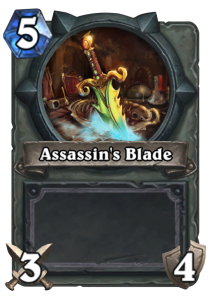 |
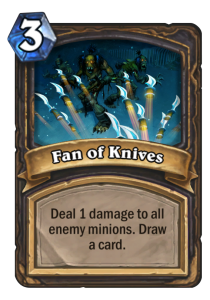 |
 |
| Level 2 | Level 4 | Level 6 |
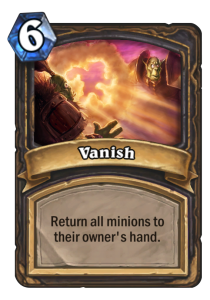 |
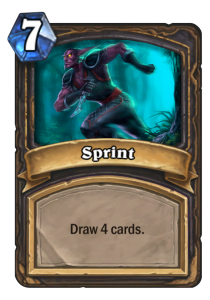 |
| Level 8 | Level 10 |
Every few levels past level 10, you will be rewarded with a Golden version of one of the Basic cards. Leveling up past 10 doesn’t give you any competitive edge – all the rewards are cosmetic.







































